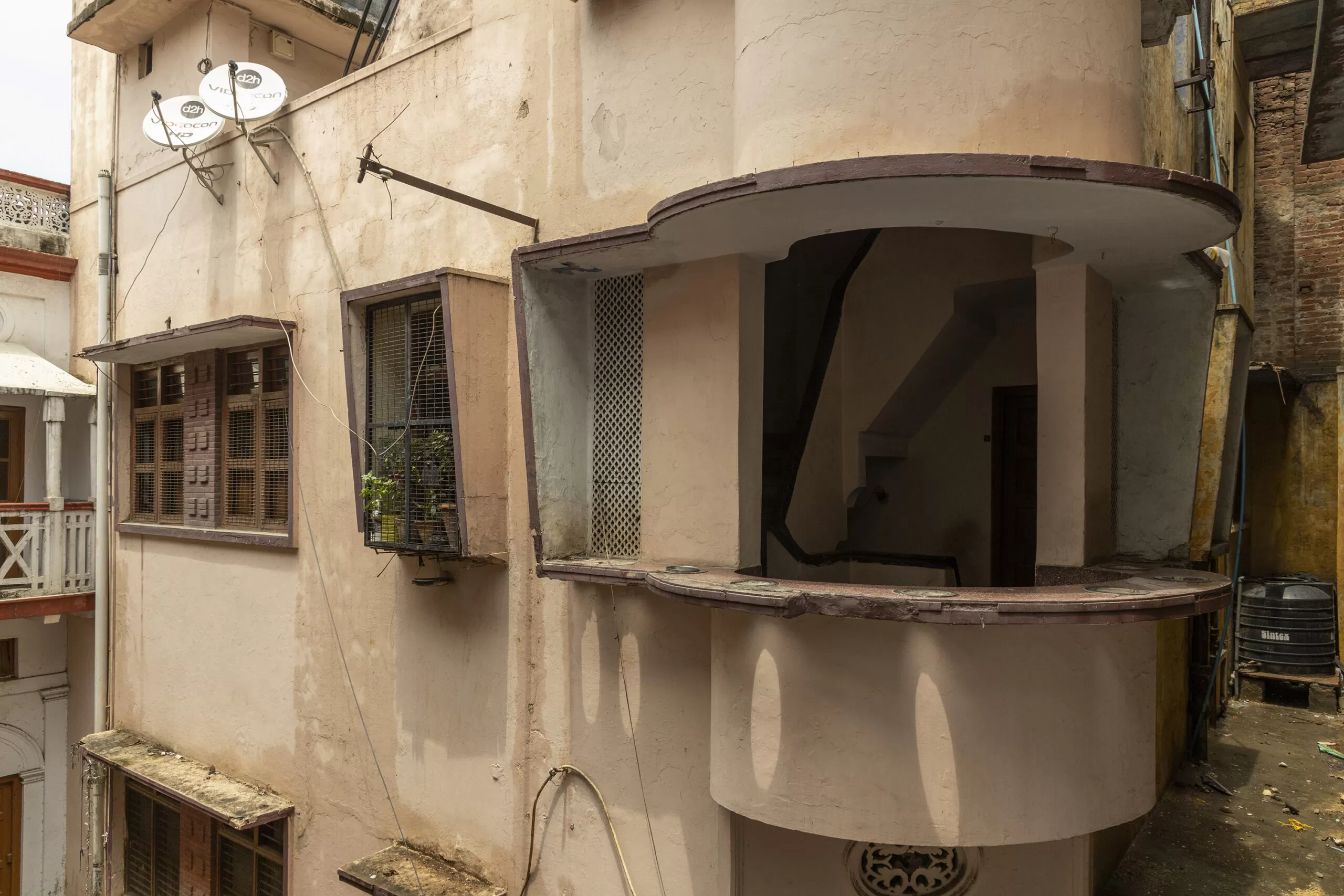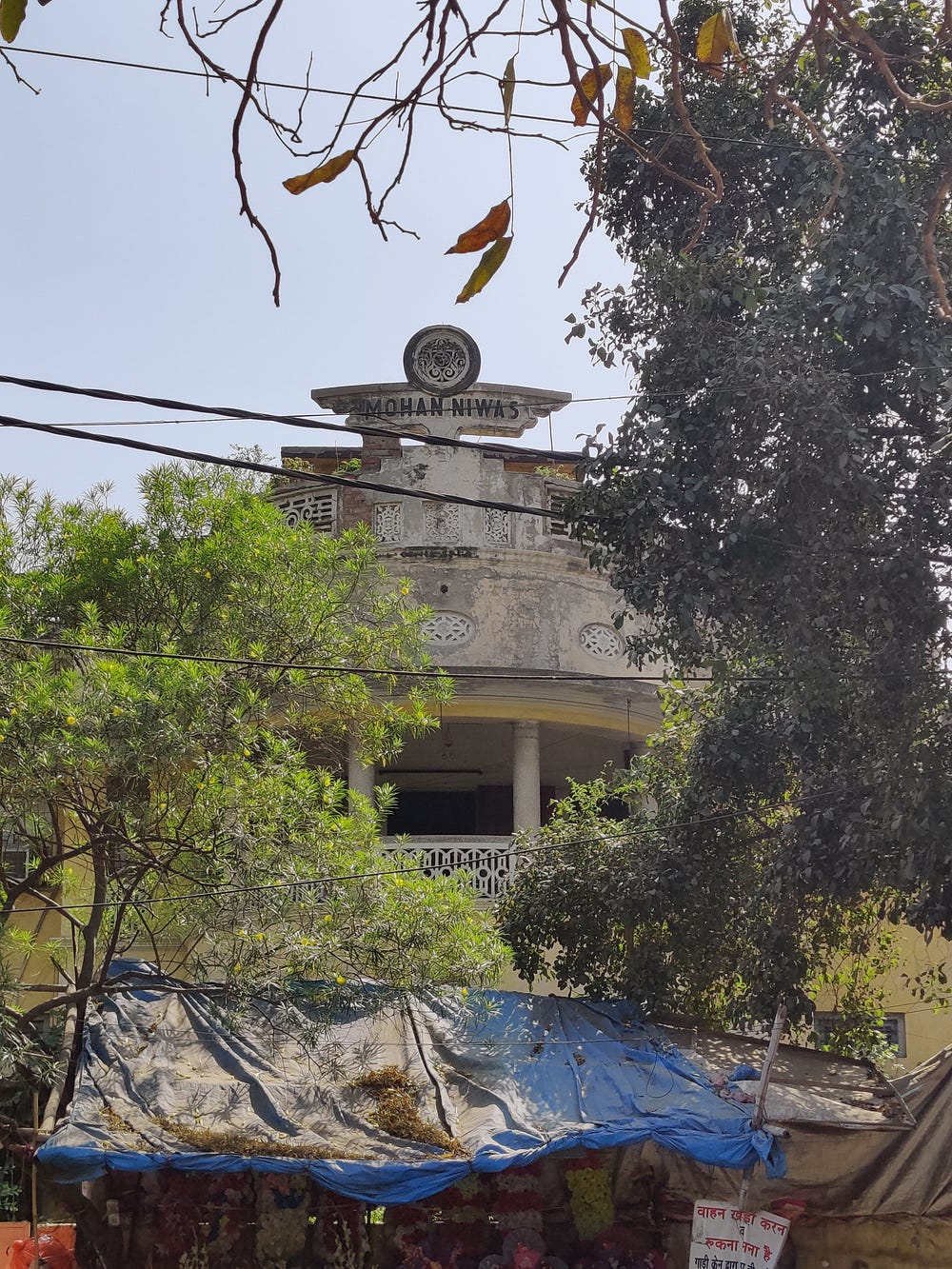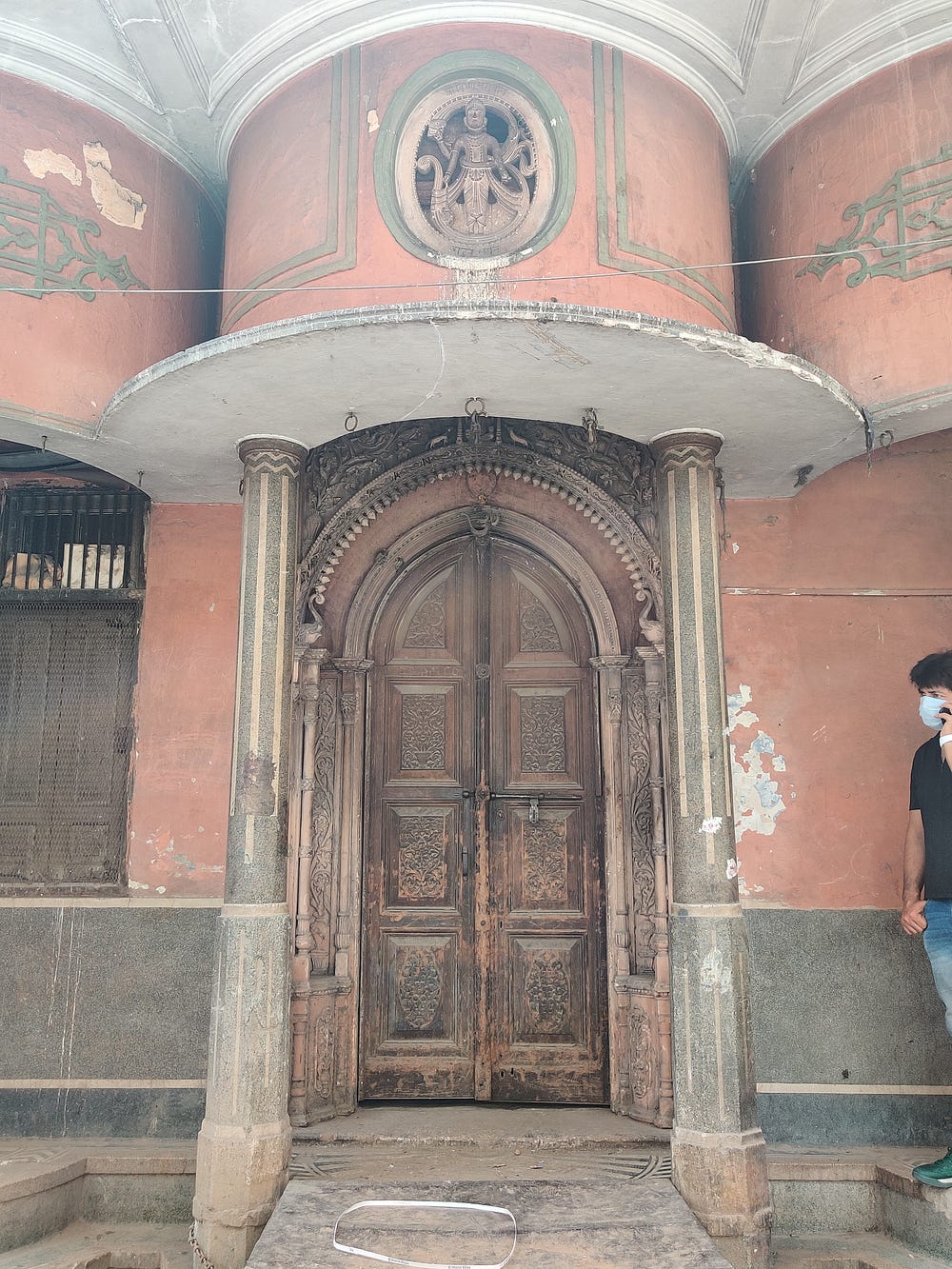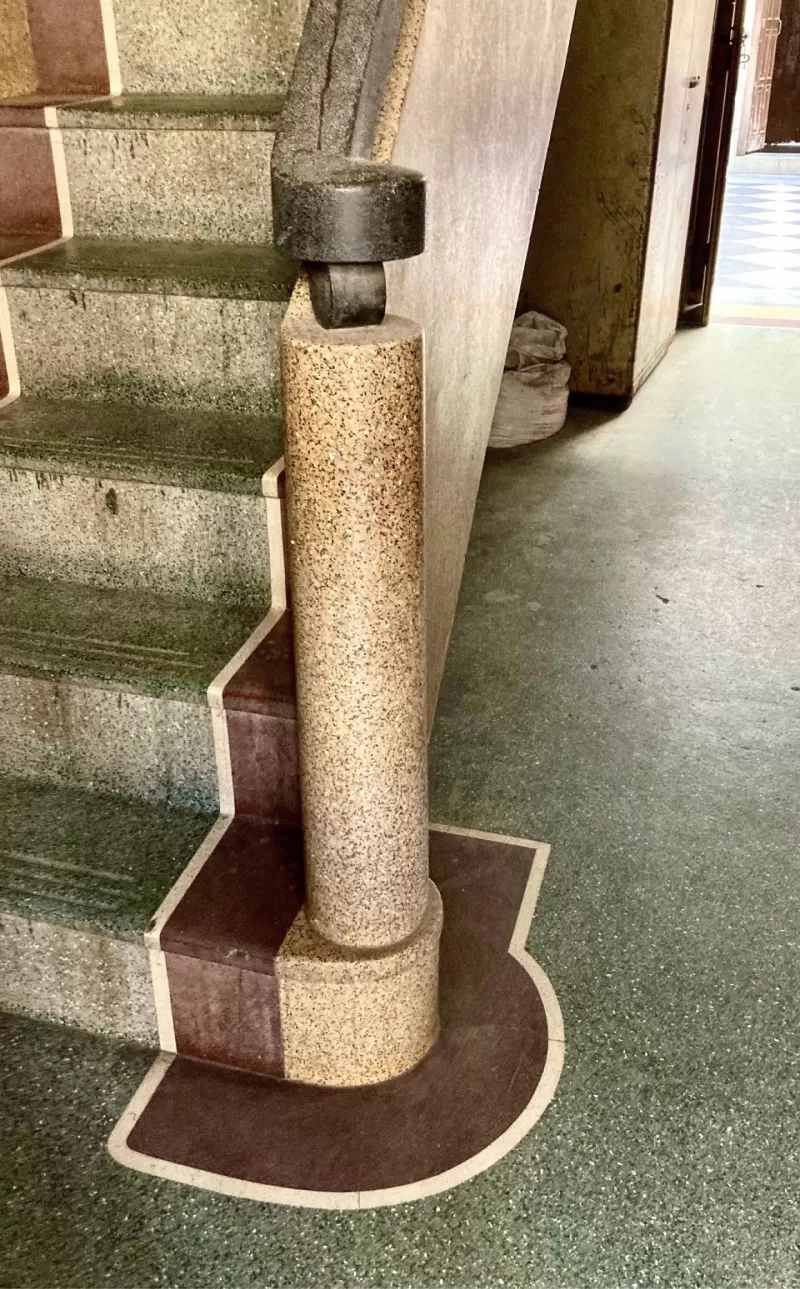‘Modern Kitchen Design — Homes in India’ series of the newspaper, 1939, were surely indicative of a steady change. Designs showcasing closed cabinets, shelves and chimneys advertising a refined look and feel to the kitchen space. There is also a pantry next to it and a kitchen garden on the rear. This seemingly fanaticized imagination is what modern homes were getting equipped with, hinting of a progression in society, life and livelihood. No more were kitchens associated with ‘choolah’, a semi open space to cook in the verandah, perhaps the notion of verandah absolutely changed by the mid twentieth century. Desires for a modern living and influences from the west led to numerous changes in patterns of habitation, utility and leisure, transforming the humble house to a modern machine.
Recounting times when havelis would exist in totality, Jyoti Hosagrahar describes a scenic imagery of Haveli Qamar al din Khan, nothing less than a small neighborhood itself or better called — a mahalla. It had several structures and spaces within, a public reception area, gardens and quarters for women of the household, typically surrounding a smaller inner courtyard. ‘There was also accommodation for an entourage of professionals, artisans, soldiers and servants under the patronage of the noblemen.’ (Hosagrahar, 2005, 17)
In addition, there were mansions for the daughters and smaller apartments or houses for the accountants and clerks. The spaces and activities around them, pertaining to the inhabitants, had a clear hierarchy. The bigger courts, specially near the entrance, were for the patriarch, while smaller courts and verandahs connected all different pockets across the mahalla. From broader streets to the narrowest in the inner lanes of the smaller court, the hierarchy evident in access as well. However this grand and complex spread of smaller units and complexes were all contained within walls of the compound. Each haveli’s grandness could have been judged by the entrance gates and halls — the more artistic the expression with exquisite details, the more would be considered wealth and authority of the Amin.
But after the siege of the city in 1857, this equation changed completely. No more were Amins considered as nobles in the British court with certain ranking and order, and neither was there wealth to maintain the lavish city. In addition, the British punished the mutineers by confiscating their property, restructuring and selling them off as per their whims. (Hosagrahar, 2005, 23) If this wasn’t done, then nobles themselves would often sell off part by part of the haveli, from a single room to independent units, to sustain themselves, leading to the fragmentation of the haveli complexes and diluting the urban fabric of the city. New residences and commercials came up in small by-lanes, which once would have been used as passages. A contemporary residence adjoined with a centenary old part of a haveli, offered a mix which represents the stylistic challenges people could have faced. The need to reflect on the history and to differ to adopt modern styles at the same time often led to many experimental outcomes. While new buildings were coming up, many were also renovated as per contemporary order. These changes certainly paved the way for Art Deco to be adapted as a popular style, especially as the style offered a modern outset but permitted individuals artistic possibilities with which they could represent their inclinations to specific elements of the past. Additionally, the style could blend with other architectural or ornamental expressions. Perhaps such was the case with many entrances that one observes while walking around Shahjahanabad. Terrazzo clad with intricate patterns, in a similar manner to those of sandstone work in havelis, representing traditional settings in a modern material.
One such instance is of Kailash Sadan at Katra Kushal Rai, Kinari Bazar. Hiding inside labyrinths of the older quarter, is this Art Deco residence, too modern for its surrounding havelis, but aptly justified to the little corner space Aggarwals, owners of Kailash Sadan, had. ‘Mathuro ka Mohalla’, as the Aggarwals recalled, once housed the haveli of Raja Kushal Rai, an important administrative member of the Mughal King Shah Alam. (Hosagrahar, 2005, 41) Post the siege, the haveli was divided into 8 families, one such being Jains, however the neighborhood remained with many open spaces and large trees, often these being the bagh and stables for the horses, which gradually got subdivided and further sold. Owners of Kailash Sadan, Shri Satya Narayan Aggarwal and Kaishashwari Devi, originally from Etawah, Uttar Pradesh, were tenants to three Jain brothers, Hazuri Lal, Moti Lal and Mistri Lal, who possessed large parts of land and decided to sell off the land having their horse stables. This is when Aggarwals decided to purchase the land and built their own residence here in 1945. Architect Om Prakash Goyal, from the first set of Architects to the city, with a few projects running around Connaught Place, designed their residence in a relatively contemporary style. Neighbors older than Aggarwals recall the openness and trees that Kushal Rai had, accusing new interventions that led to many cramped spaces. Perhaps this is why, Architect Goyal decided to open up the corner with a striking curved balcony, a statement for the house till day. The corner has the staircase entrance, cladded with Marble which Aggarwals got from Makrana, and over it, flanks the balconies, adorned with eyebrows and in-built planters, all of course in terrazzo, material of those decades. Apart from the swanky balcony, the house has a central courtyard around which are the habitable spaces. On one corner is the Kitchen, a modern open kitchen for the time with subtly curving counters, the most ‘updated’ of all spaces, letting the aroma in the entire house. Mantels and counterfeit fireplaces, like many others residences built around the same time, adorn the rooms, an omnipresence of the Empire and copy of the classical styles. A curved seater on the terrace completes the decorative elements of the house, where people would have spent the most time and used to rest, especially over summer nights. The house, as morphologically stuck between the haveli and contemporary order, is also a blend of a few traditional practices with modern interfaces.

However the transition between Havelis to Modern dwellings wasn’t so smooth. With the British setting foot in Delhi, most started to reside towards Civil Lines, out and a little away from the older quarters into a space carved by the British themselves. These residences, better called ‘Bungalows’, brought a wave of classist changes into the city. By definition, a humble single storied detached hutment, specially found in the region of Bengal (Webster, 1972, 111), came to be known as British Bungalows in Delhi. With Delhi being established as the new capital from Calcutta, a housing style brought from Bengal, altered to the suitability of the Raj, was less improvisation for the British than repurposing lifestyles for the Haveli owners. A house surrounded by greens, with verandahs and porches complemented with colonnades, ornamentations of Classical order and interior furnishing of plasterwork, often with the absence of a central court, the bungalow was a concept away from the Havelis. While the Haveli’s sense of space started from the very entrance, marking its prominence from the attached houses, the bungalow brought with itself notions of a boundary wall and the gate with green buffers between neighbors. It also introduced similar spaces with modern alterations, a dining room and a living, which in the havelis would be halls and courts with food placed on mats on the floor. Fireplaces with mantels to keep the house warm and yet decorative. In terms of spatial behavior and hierarchy, the bungalow got many changes to the haveli setting.
Post 1857 with the decline of the nobles of the Mughal Court and fragmentation and expansion of the older quarters, many affluent people left towards the Civil Lines, to bungalows, which were the new synonyms of wealth. Rai Bahadurs, Rais and even Rajas would design their houses in the Bungalow style. Mohan Niwas on the Bungalow Road, residence of Rai Sahab Mathra Das Baury, stands as an example. The residence set inside from the road, hiding behind greens, has a curved façade and a verandah marked with columns. Eyebrow-like overhang and most strikingly, a banner-like name plate resembling a ship’s crest, distinguishes it from the others. The bungalow, true to the Art Deco’s streamline, is modern and grand, adorned with intricate patterned jaali work for grills, setting itself in the visual harmony of other bungalows of the road, each as objects in space.
The classist divide the bungalow brought was evident. While some rejected the bungalow as a residential unit in contrast to the Haveli, many thought of it as a method of bringing a new identity, at par with the British. (Hosagrahar, 2005, 37) The British too considered a Bungalow as a ‘basic requirement for entertaining Europeans’, for the walled city in their eyes was nothing more than ‘filth, congestion, irrationality and superstition in opposition to the bungalows and civil station that epitomized reason, civilization and science — qualities that exemplified progress.’ This ‘progress’ perhaps led to the decay of the haveli, which without any care and further fragments became storages for transiting goods or shelter for migrants. (Hosagrahar, 2005, 38)
The Bungalow grew as a typology, from a single storyed unit to one with multiple floors, understood quintessentially as a single family detached dwelling. This was true for the later examples seen in the city as well. For Arvind cottage at Roop Nagar, the bungalow is a double storey residence with bulging cylindrical corner towers, an entrance porch and curved balconies. This bungalow, similar to Mohan Niwas, belongs to the Streamline doctrine of Art Deco and showcases eyebrows, flutes and bandings on its facade in addition to its overall form and mass. Despite being built within a span of more than a decade, the bungalows surely were popular amongst the wealthy.

The fragmentation of the older quarters along with movement and migration into the city, given the establishment of New Delhi or for further trade and commerce before the partition, brought the walled city on the brink of a health hazard. Miscalculations and lack of investment into it later led to much chaos which till day is under rectification. (Legg, 2007, 198) Seeing the mismanagement of public infrastructure and the health crises, post many negotiations, the Delhi Improvement Trust was formed in 1936, headed by AP Hume. (Jain, 2015) (Mehra, 2013) The primary task of the Improvement Trust was to control malaria and other health hazards by supporting the city’s infrastructure laid by the Municipal Corporation of Delhi. Along with infrastructure, the Trust took upon the tasks of development and expansion schemes for the city to house a growing category of people which appeared in masses with the onset of the new capital- the working class and clerks, a new structure of nuclear households for ‘on duty’ needs, rotated from person to person.
After a flow and shuffle of responsibilities from the Delhi Town Planning Committee (DTPC) to the Imperial Delhi Committee (IDC) that subsequently became the New Delhi Municipal Committee in 1927, the fortune of the Indian and European Clerk as well as of the margins of the new city, rested with the NDMC, basis reports by the DTPC. (Legg, 2007, 43) Indian Clerks were placed near Paharganj and closer to the over sprawling old Delhi, while the European Clerks would be south to them. Division of houses and spaces in them was the basis of the position of the clerk and his nativity, a European given better facilities than the Indian counterparts. As Legg comments, ‘Zoning separated individuals inhabitants from their social context and abstracted them to the level of social functionality; what they did for the government and thus what they deserved in material benefits.’ (Legg, 2007, 43)
While officers were mostly ‘white’ and stayed in Bungalows, cheaper flats were made for the ones on the lower ranks. But the people, approximated over 12000 who had come to construct New Delhi and then disregarded, also sprawled along the margins of the older city. (Legg, 2007, 64) The Trust faced challenges to rehouse people and also to provide for appropriate dwellings. The house, from havelis to bungalows is now a shared building, with a room to oneself, specially for the unmarried clerk or a room set to the married ones. More like chawls today, the ‘flats’ shared a common washroom or provided for smaller spaces for utility purposes only. Bungalows on the other hand, could enjoy a set of luxuries.
“For instance, one of the most prestigious ‘bungalows’, on King George Avenue, consisted of a hall, living room, dining room, study, sitting room, 6 bedrooms and bathrooms, 2 dressing rooms, 2 garages, 3 stables and 13 servants’ quarters. In contrast, the lowly peons dwelled in terraces of one room quarters.” (Legg, 2007, 48)
While drawing from traditional settings, cultural behavior and incidental damages of ill planning, the Trust provided for a set of guidelines or building laws and often offered design suggestions. Many influential people of the city were its members and part of the Sub Committee that looked into design, such as Lala Shri Ram, the biggest industrialist in the city, Sir Sobha Singh, the most blooming contractor of town and Architect Walter Sykes George, Baker’s assistant and substitute during the New Delhi Project. (Delhi Improvement Trust, 1938) (Butler, 2012) With the society segregated on class and ranks, government employees to others, natives to Europeans and later natives to migrants, the house changed many meanings. The Trust tried to provide to a range of people with many options, flats as shared housing for the poor, as in Regharpura; small to mid range plots for individual row houses for the middle to upper middle classes, as in Western Extension Area, Karol Bagh and Daryaganj South; and bigger plots for bungalows, residences of PUSA road and some of Daryaganj are precedents of these. These are also examples where Deco spread amongst the masses and was further carried to pockets such as Roop Nagar and Kamla Nagar after partition.
The drawings and remaining physical examples from Regharpura show flats following a linear and simple principle, staircase in the center, a little higher in profile that the terrace, creating a vertical emphasis on the central axis, highlighted with jaali work. The jaali was probably a low cost and efficient method to bring in light and ventilation to a common space, yet articulate it beautifully. Each flat will have at least one balcony on either face, curved at the corner with an overhang for sun protection. A similar pattern with slight variation is seen at the Pandit Dhar Apartments at Western Extension Area, built for the middle classes, where there is an absence of balcony and overhangs, but provision of widely recessed verandahs between the staircase tower and another protrusion, both curved to rhythms of streamline moderne with low relief work, portholes and jaalis and a recessed boundary wall. Both examples set a typeset for apartments and even multi storey houses in the city, of a central entrance and staircase with jaali work and curving balconies for each subsequent floor. Yet, with the trust’s stated guidelines, courtyards and well lit staircases formed a set pattern of row houses, the sizes depending upon the plot size for better natural light and ventilation to spaces.
The only anomaly to the standard apartment pattern, built to house officers during the WWII were Sujan Singh park flats. Built under special permissions and grants, without the need of approval from the Trust, the flats dropped the verandah that was evident otherwise. (Sujan Singh Park Traders Association, 2011) Just curved balconies jutting out from the facade marks it Streamline resemblance and the archway entrances, of classical insertions. A hybrid in style and spatiality.
The row houses of Darya Ganj and Kamla Nagar abing by a similar spatial pattern, of central courtyard, multi storey floors and central staircases, but additionally reflect on ornamentation, often representing religious opinions and many times of socio-political changes, specially voicing the ideology of swaraj. The house has forever been a mode of expression and representation of one’s identity and many did reflect the choice of an independent nation with a distinct identity to their residence’s architectural language, adding Jai Hind and the flag on the facade. In seeking a voice for identity, ‘Charan Bhawan’ at Model Basti and the other referred to as Unchi Kothi of Ballimaran, literally meaning the tallest house, stand exemplary.
Charan Bhawan is perhaps the most interesting of all residential spaces one could explore. A corner plot where adjacent facades show a distinct language, designed differently for the brothers Charan Singh Gupta, Bharat Singh and Rama Singh Gupta, it’s a unique house which speaks for the blend of traditional motifs in a modern streamline format. Charan Singh was a contractor and supervised the construction of the house, the most popular one in the neighborhood. The family had several other properties but none could match the character of streamline curves and intricate details of this house. The facade along the road, ‘Bharat Bhawan’, is less of streamline yet absolutely ornate as Charan Bhawan. A central staircase rises from it and meets at the first floor, where a separate spiral staircase runs for Charan Bhawan. Placed between the balconies, the staircase is the central tower which has intricate jaali work and cement crafted plant pots on either side. The most famous feature of the house, a seater on the terrace, circular in shape merging with the spiral staircase, with a canopy over it. The canopy once had light bulbs over each droplet to the rim and water would run to it from the tank built specially into the canopy. A carousel which the entire neighborhood would watch for. Interestingly, these elements of never-seen-before state of art and innovation were clubbed with intricate sandstone relief and carving, with gods and goddess, as close to traditional haveli setups as possible. Never has one seen a house with a water and lights carousel over their terrace and never would one witness a house like Charan Bhawan, a mould of modernism with coverings in tradition. Perhaps this is where the point of divergence in Art Deco from its global style emerges to Indo Deco, which is more than adjustments and amalgamation of the style to its immediate surroundings, but a layered insertion of clearly distinct choice, particularly for its ornamentation.

Similar to Charan Bhawan, Unchi Kothi offers an extremely intricate visual appearance to streamline modern profile. Being built by a merchant from Calcutta, Ismail, initially for his personal use, the house with subtly curving balconies and a stunning small canopy over a tower on the terrace, aligned to the diagonal axis of the corner house, offers extremely intricate geometric pattern laid jaalis which makes a distinct visual delight. One has to imagine the impact the residence would have created on an otherwise low rising Balllimaran, where this was called Unchi Kothi and now is almost unnoticeable between many tall risers and multiple wires hanging afloat.
Had the two residences been true to streamline, their choice for ornamentation would have been much simpler or like those of the other residences in their respective neighborhoods — carefully balanced bands and plasterwork, as minimal as the choice for streamlined forms. But the choice here clearly demarcates consciously evaluated preferences of iconography and patterns of the past.
Away from the row houses, the bungalows of Pusa Road, addresses of the new Rais of town were coming up, all in ‘Bombay style’, the name by which Streamline bungalows were known credited to an architect who took most residences of the area, NK Kothari. Kothari worked previously with Bombay based trio Master, Sathe and Bhuta, who were one of the first set of Indian architects in a British dominant sector. Nearing independence and soon after, they saw an unparalleled number of projects across the nation, noticeably credited for banks and institutions. Kothari was the Delhi incharge for their projects but soon ventured to lead Master Sathe Kothari and subsequently formed his own practice here. These residences would follow a similar pattern, bulging staircase towers, curved volumes and overhangs to all openings, specially eyebrows to verandahs.
A common feature that most Art Deco buildings and specially the residences adopted was carefully laid staircases. Following a spiral or helical format or certainly a continuous flow without any breakages, the stair would be the heart of the building. Laying an emphasis on the horizontal flow rather than the vertical rising, the balusters were often replaced with brickwork and cladded in terrazzo. Terrazzo and wood, the two most used materials, mastered the joinery of seamless and edgeless work. Another feature peculiar to Deco is the use of typography, which has laid memories of residences for almost a century till date. Casted in terrazzo or inserted over, a trend mastered by the cinemas and hotels of the 1940s.

Much alike the kitchen design advert, houses, their patterns, needs and family structure itself has changed. New ideas, ideology, movement and migration has led to different suitability and needs for people. From homes with lack of electricity to homes with powered workstations, dynamics and needs of houses expanded greatly over time.
“The social processes that have been variously labeled ‘globalization’, ‘westernization’ and ‘modernization’ reshaped middle income Indian life.” (Desāī et al., 2012)
However, sociability and a sense of community remains common. Be it havelis with a community within or bungalows with a sense of belonging more than the community or apartments which were a result of social housing, or row houses which represent a cluster as a unit, sociability and community has been at the core of one’s existence. Here one notices the need of representation and showcase of identity, as detached from the British, as modern with the world, as placed in one’s roots or as voicing the signs of Arya Samaj and Swaraj. The house is certainly a self growing unit, that weaves the past to the future and offers to the present. Slowly it adapts to the changing norms of the society, to modern materials and developed spaces, adjusted to altered cultural behaviors, in a comforting space called ‘home’. “A home is after all a symbol of who one is.” (Cooper, 1974, 111) Together in a glance, the city still possesses most of these dwelling types, some as fragments and dilapidated structures, some still bolstering their stylistic prominence. From an individual to a large family structure, all parallels grow in a city together, existing and appreciating the balance that each brings or perhaps the divisions the society bears.
It is interesting to observe how Art Deco as a style could blend with fragmentation and emergence all throughout the twentieth century, yet leave a mark of its presence, influencing itself onto the minds of the masses. Many claim Deco easily blends with a region or with another style, but here, it harnessed an identity of its own, while accommodating to the changes. It is certain, developments specially with materials and industries helped it further, prints and magazines permitted its spread, the air of modern movement nurtured its growth, yet it was the style itself to propagate the minds of individuals, who saw this as their window to weave the past to future.
The style, introduced with the onset of palatial palaces of the Maharajas in New Delhi and moved to the middle class masses around independence. Perhaps it’s because of the styles’ vast possibilities that these transitions seem to be blended, weaving the fragments and parts of society under its wide umbrella. Yet style is surely best known to the residents of the city, who enjoyed summers on the terrazzo laid floors, winters in the sun through their courts and called their residences with the different names encased in stone. The kitchens have certainly moved around, from choolahs to shafts to chimneys, modern living’s utility with the style’s harmony.
